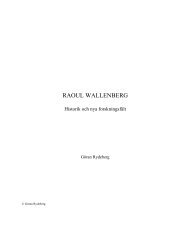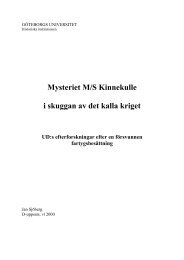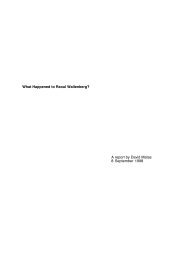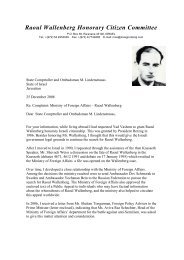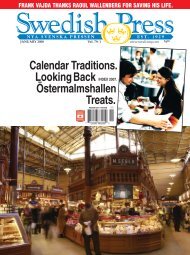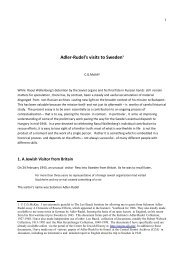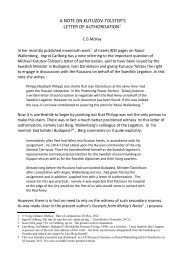The Secret of Cell Number Seven - Searching for Raoul Wallenberg
The Secret of Cell Number Seven - Searching for Raoul Wallenberg
The Secret of Cell Number Seven - Searching for Raoul Wallenberg
Create successful ePaper yourself
Turn your PDF publications into a flip-book with our unique Google optimized e-Paper software.
<strong>The</strong> <strong>Secret</strong> <strong>of</strong> <strong>Cell</strong> <strong>Number</strong> <strong>Seven</strong> Vadim J. Birstein<br />
This article was first published in Russia by Nezamisimaya gazeta: “Taina kamery nomer sem”, p.4, April<br />
25, 1991 and republished later that year in Poland by Gazeta Wyborcza: Birsztein, W, “Kiedy zginal<br />
<strong>Wallenberg</strong>?”, No. 165 (634), July 17, 1991, p. 9 (translated into Polish) . In references to the materials<br />
presented below, please, cite the Russian source or this site. <strong>The</strong> additional comments were written in<br />
2006.<br />
<strong>The</strong> <strong>Secret</strong> <strong>of</strong> <strong>Cell</strong> <strong>Number</strong> <strong>Seven</strong><br />
<strong>The</strong> Mysterious Fate <strong>of</strong> An “Extremely Important Prisoner”<br />
(translated from the Russian by the author)<br />
Dr. Vadim J. Birstein<br />
In January 1944, Franklin Delano Roosevelt, President <strong>of</strong> the United States, organized the War<br />
Refugee Board in an ef<strong>for</strong>t to save Jews and other Nazi victims in Europe. A special case was<br />
Hungary, where a large community <strong>of</strong> surviving Jews was located. After the German occupation<br />
<strong>of</strong> Hungary on March 15, 1944, only <strong>for</strong>eigners from neutral countries could undertake<br />
humanitarian work. Through international diplomatic negotiations, it was decided to open a<br />
special section at the Swedish Legation in Budapest. <strong>Raoul</strong> <strong>Wallenberg</strong>, a young man who had<br />
had no previous involvement in politics or in diplomacy, was appointed head <strong>of</strong> this section. On<br />
July 19, 1944, this thirty-one year old Swede came to Budapest with one goal: to prevent the<br />
extermination <strong>of</strong> the Jews in Hungary.<br />
A special Section, C, was organized at the Swedish Legation <strong>for</strong> <strong>Wallenberg</strong> and his colleagues.<br />
At the same time, Section B, representing Soviet interests, was created. It consisted <strong>of</strong> a Belgian<br />
citizen (and a <strong>for</strong>mer Russian count), Michael Tolstoy-Kutuzov, and a half-German, half-<br />
Ukrainian, Hermann Grosheim-Krysko, who was born near the city <strong>of</strong> Rostov-on-Don in<br />
Southern Russia and who worked at the legation under the pseudonym Heinrich Tomsen. His<br />
<strong>of</strong>ficial job was to interview Soviet prisoners-<strong>of</strong>-war (POWs).<br />
<strong>The</strong> work <strong>of</strong> Section C would not have been possible without the help <strong>of</strong> a number <strong>of</strong> people who<br />
courageously fought against the German and Hungarian Nazis. <strong>The</strong>ir network included the Swiss<br />
diplomat, Carl Lutz; Papal Nuncio Angelo Rotta; people who worked <strong>for</strong> the Red Cross; some<br />
representatives <strong>of</strong> the Government <strong>of</strong> Admiral Miklos Horthy; Hungarian aristocrats; and the<br />
Jewish underground in Budapest. Along with <strong>Wallenberg</strong> and his assistants, they saved<br />
thousands <strong>of</strong> lives.<br />
Disappearance<br />
On January 17, 1945, <strong>Raoul</strong> <strong>Wallenberg</strong> was seen in Budapest <strong>for</strong> the last time, with his driver,<br />
Vilmos Langfelder, in the company <strong>of</strong> two Soviet soldiers. What happened to <strong>Wallenberg</strong> and<br />
Langfelder after this date is shrouded in mystery. A day be<strong>for</strong>e <strong>Wallenberg</strong>’s actual<br />
disappearance, on January 16, Vladimir Dekanozov, Soviet Deputy Commissar <strong>for</strong> Foreign<br />
Affairs, in<strong>for</strong>med the Swedish Embassy in Moscow that <strong>Raoul</strong> <strong>Wallenberg</strong> was found and he<br />
was being kept in Soviet custody. A month later, <strong>Raoul</strong>’s mother, Maj von Dardel, received a<br />
note from the Soviet Ambassador in Stockholm, Aleksandra Kollontai, that stated that <strong>Raoul</strong> was<br />
Page 1 <strong>of</strong> 9 © Vadim J. Birstein 2006
<strong>The</strong> <strong>Secret</strong> <strong>of</strong> <strong>Cell</strong> <strong>Number</strong> <strong>Seven</strong> Vadim J. Birstein<br />
in Russia. Soon after this, <strong>Wallenberg</strong> “disappeared” without explanation or a trace. A rumor<br />
was circulated that bandits killed him near Budapest. Count Tolstoy actively promoted this<br />
rumor.<br />
After Budapest was occupied by Soviet troops, the Swedish Legation was vandalized and<br />
robbed. <strong>The</strong> diplomats were taken to Moscow. Only two months after the occupation <strong>of</strong><br />
Budapest and three months after <strong>Wallenberg</strong>’s disappearance, the Swedish diplomats were<br />
returned to Stockholm. During this time, Count Tolstoy, who was never arrested, worked at the<br />
Soviet administration in Budapest. (Later he lived in Ireland, where he died in 1980). As <strong>for</strong><br />
Grosheim-Krysko, alias Tomsen, we now know that on February 8, 1945, he was arrested by<br />
Soviet military counterintelligence, SMERSH (an acronym from the Russian words “Death to<br />
spies”). However, he was not sentenced by the OSO (the Special Council <strong>of</strong> the State Security<br />
Ministry, MGB, that convicted arrestees charged with committing political crimes, including<br />
espionage), until January 12, 1952. Grosheim-Krysko was given a 25-year sentence in Vladimir<br />
Prison, <strong>of</strong> which he served only six months. In his last letter to Vladimir Prison authorities, he<br />
mentioned that his sentence was a mistake because he had always been an admirer <strong>of</strong> the Soviet<br />
Union. In July <strong>of</strong> 1953, Grosheim-Krysko was repatriated to Eastern Germany (later he lived in<br />
Western Germany). Eventually, he appeared in Sweden where he contacted <strong>Raoul</strong> <strong>Wallenberg</strong>’s<br />
family, possibly to find out how much they knew about the <strong>Wallenberg</strong> case.<br />
On July 15, 1946, Joseph Stalin, the Soviet dictator, gave an audience to the Swedish<br />
Ambassador, Staffan Soederblom. It was an exception to protocol because usually Stalin did not<br />
meet with ambassadors from neutral countries. <strong>The</strong> Ambassador described <strong>Wallenberg</strong>’s mission<br />
and his disappearance. Unaccountably, he expressed his own personal opinion that <strong>Wallenberg</strong><br />
had been a victim <strong>of</strong> bandits near Budapest. Stalin answered that the situation with <strong>Wallenberg</strong><br />
would be cleared up. From this moment until 1957, Soviet <strong>of</strong>ficials held to the story that<br />
<strong>Wallenberg</strong> “had never been in the Soviet Union and we do not know who he is” (from<br />
Vyshinsky Note dated August 18, 1947). In fact, at the moment <strong>of</strong> Soederblom’s conversation<br />
with Stalin, <strong>Wallenberg</strong> was in <strong>Cell</strong> 203 <strong>of</strong> Le<strong>for</strong>tovo Prison, fifteen minutes away from the<br />
Kremlin. <strong>The</strong> Swedish government thus lost a critical opportunity to save him.<br />
A New Soviet Version<br />
On February 6, 1957, Andrei Gromyko, at the time Soviet Deputy Foreign Minister, presented a<br />
memorandum to Swedish diplomats. This note (known as the Gromyko Memorandum) was<br />
written after Nikita Khrushchev (Stalin’s sucessor) promised the Swedish Prime Minister, Tag<br />
Ehrlander, “to clear up the matter” <strong>of</strong> the <strong>Wallenberg</strong> case. <strong>The</strong> Memorandum declared that the<br />
search through “every page” <strong>of</strong> archival materials produced only one document related to <strong>Raoul</strong><br />
<strong>Wallenberg</strong>, the Smoltsov report to the MGB Minister, Viktor Abakumov. In the 1940s,<br />
Aleksandr Smoltsov headed the Medical Department <strong>of</strong> Lubyanka Prison. <strong>The</strong> report stated that<br />
“the prisoner, Walenberg, whom you know, died tonight --probably, from a heart attack.” It<br />
should be noted that the name <strong>Wallenberg</strong> is spelled with one “l” while in the other <strong>of</strong>ficial<br />
documents it was always spelled with two “l’s” [However, writing the name <strong>Wallenberg</strong> with<br />
one “l” was typical not only Smoltsov, but <strong>for</strong> other poorly educated MGB <strong>of</strong>ficers—V. B.,<br />
2005]. Below the main text there was an additional note: “<strong>The</strong> Minister has been in<strong>for</strong>med. It<br />
was ordered to cremate [the body] without autopsy. 17/VII [July 17, 1947]. Smoltsov.” <strong>The</strong><br />
Page 2 <strong>of</strong> 9 © Vadim J. Birstein 2006
<strong>The</strong> <strong>Secret</strong> <strong>of</strong> <strong>Cell</strong> <strong>Number</strong> <strong>Seven</strong> Vadim J. Birstein<br />
Gromyko Memorandum added that because Smoltsov died in 1953 and Abakumov was executed<br />
a year later, no additional in<strong>for</strong>mation could be found.<br />
Prior to this, evidence appeared in Western countries that <strong>Wallenberg</strong> and Langfelder had been<br />
seen in prisons and labor camps inside the USSR. In 1946, the Swedish journalist, Edward af<br />
Sandeberg, was the first to write about <strong>Wallenberg</strong> being present in the Soviet Union. Sandeberg<br />
was arrested in Berlin in 1945, then <strong>for</strong> a year he was kept as a POW near Moscow be<strong>for</strong>e finally<br />
being repatriated to Sweden. Sandeberg mentioned a German, Erhard Hille, who ten years later<br />
gave a detailed testimony to the Swedish authorities about <strong>Wallenberg</strong>’s imprisonment. From<br />
1956 on, many repatriated <strong>for</strong>eigners described <strong>Wallenberg</strong> and his driver in Moscow prisons in<br />
1945-47. Until the 1980s, many stories—mostly not credible—appeared about <strong>Wallenberg</strong>’s<br />
imprisonment in Vladimir Prison (the most secret Soviet prison <strong>for</strong> convicted political prisoners)<br />
and many Soviet labor camps.<br />
On June 2, 1989, Yurii Kashlev, a Soviet diplomat and head <strong>of</strong> the Soviet delegation at the Paris<br />
Conference on Humanitarian Problems, announced that “<strong>Wallenberg</strong> was killed (executed) in<br />
1947 and those who eliminated him, were, after this, killed themselves.”<br />
On October 15, 1989, <strong>Wallenberg</strong>’s family—Dr. Guy von Dardel and Nina Lagergren, <strong>Raoul</strong>’s<br />
half-brother and half-sister—along with Ambassador Per Anger and Sonya Sonnenfeld, Chair<br />
and <strong>Secret</strong>ary <strong>of</strong> the Swedish <strong>Wallenberg</strong> Association, came to Moscow on the invitation <strong>of</strong><br />
Soviet authorities. Be<strong>for</strong>e <strong>Wallenberg</strong>’s arrival in Budapest, Per Anger, at the time <strong>Secret</strong>ary <strong>of</strong><br />
the Swedish Legation, had begun to hand out Swedish Schutz-passes to the Jews.<br />
<strong>The</strong> KGB representatives showed them the original <strong>of</strong> the Smoltsov report and a box with <strong>Raoul</strong><br />
<strong>Wallenberg</strong>’s possessions at the time <strong>of</strong> his arrest. This included his diplomatic passport; an ID, a<br />
diary; a golden cigarette case and money in old dollars and Hungarian pengos. Also,<br />
<strong>Wallenberg</strong>’s registration card from Lubyanka Prison was shown. After some hesitation caused<br />
by the guests’ refusal to sign a receipt, the head <strong>of</strong> the KGB Central Archive, Major General<br />
Fokin, gave the box and a copy <strong>of</strong> the prisoner card to <strong>Raoul</strong>’s relatives. He said that <strong>Raoul</strong>’s<br />
belongings were accidentally found in a bag in KGB storage, just be<strong>for</strong>e the family’s arrival. To<br />
all later requests to see the person who had found the bag, the response was “it is not expedient.”<br />
<strong>The</strong> Swedish guests were also permitted to go to Vladimir Prison, where they were shown<br />
registration cards <strong>of</strong> a few <strong>for</strong>eign prisoners who had given testimonies about <strong>Wallenberg</strong> after<br />
they had been repatriated.<br />
Archives<br />
Finally, on August 28, 1990, the Joint Soviet-International Commission to Establish the Fate and<br />
Whereabouts <strong>of</strong> <strong>Raoul</strong> <strong>Wallenberg</strong> that was <strong>for</strong>med and headed by Dr. Guy von Dardel, arrived<br />
in Vladimir. <strong>The</strong> Commission was completely independent: the Soviet accepted the condition<br />
that the Swedes should pick the Commission’s members, including the author <strong>of</strong> the present<br />
article, by themselves.<br />
We could not find any trace <strong>of</strong> <strong>Wallenberg</strong>’s presence in Vladimir Prison. However, we studied<br />
registration cards <strong>of</strong> many witnesses who had testified in the West about <strong>Wallenberg</strong>. Our main<br />
Page 3 <strong>of</strong> 9 © Vadim J. Birstein 2006
<strong>The</strong> <strong>Secret</strong> <strong>of</strong> <strong>Cell</strong> <strong>Number</strong> <strong>Seven</strong> Vadim J. Birstein<br />
achievement was that we started to understand the details <strong>of</strong> the prison <strong>of</strong>fice work <strong>of</strong> the time. It<br />
became clear to us that it would have been difficult to find the <strong>Wallenberg</strong> belongings that had<br />
been handed over to his relatives all in one place. <strong>The</strong> “bag” story looked suspicious. To find all<br />
the items, one needed to look through <strong>Wallenberg</strong>’s Personal File, take out some <strong>of</strong> the items<br />
(such as the passport) and then, using receipts <strong>for</strong> valuables in the file, find the money and the<br />
cigarette case in storage. <strong>The</strong> registration prisoner card should have been taken from the file <strong>of</strong><br />
cards <strong>of</strong> Lubyanka prisoners. <strong>The</strong> card was written <strong>for</strong> “the POW <strong>Raoul</strong> Gustav <strong>Wallenberg</strong>”<br />
“who arrived on February 6, 1945, from the city <strong>of</strong> Budapest, <strong>for</strong> the disposal <strong>of</strong> the GUKR<br />
SMERSH [military counterintelligence].” Do all these details mean that, despite Soviet claims,<br />
<strong>Wallenberg</strong>’s Personal File still existed in 1989?<br />
Due to the agreement between Pr<strong>of</strong>essor Guy von Dardel and Vadim Bakatin (at the time, USSR<br />
Interior Minister), the historian Arsenii Roginsky and I were allowed to work at the Special<br />
Archive, which is now called the Central State Archive <strong>of</strong> the Council <strong>of</strong> Ministers [currently, it<br />
is a part <strong>of</strong> the Russian Military Archive—V. B., 2006]. <strong>The</strong>re, we studied Personal Files <strong>of</strong> a<br />
number <strong>of</strong> <strong>Wallenberg</strong>’s and Langfelder’s cell-mates, although not <strong>of</strong> Wilhelm Roedel or<br />
Schauer-Schliter. [We were told that these two files did not exist which later appeared to be<br />
untrue.] After we found two documents that mentioned <strong>Wallenberg</strong> and one with Langfelder’s<br />
name, and pointed to the type <strong>of</strong> archival materials that might contain then answer to the mystery<br />
<strong>of</strong> their disappearance, our work at the archive was terminated by the KGB.<br />
We did not find a lot <strong>of</strong> new in<strong>for</strong>mation. But we did confirm almost everything that the<br />
witnesses said in 1956-61. <strong>The</strong> accuracy <strong>of</strong> their testimonies was amazing. <strong>The</strong>y remembered<br />
details <strong>of</strong> their movements through the cells <strong>of</strong> Lubyanskaya, Le<strong>for</strong>tovo, and Vladimir prisons<br />
almost perfectly.<br />
In Moscow Prisons<br />
On February 6, 1945, <strong>Wallenberg</strong> was put in <strong>Cell</strong> 121 or 123 <strong>of</strong> Lubyanka Prison. Gustav<br />
Richter, the <strong>for</strong>mer Police Attaché <strong>of</strong> the German Legation in Bucharest and SS-<br />
Sturmbannfuehrer, and an Austrian, Willi Schauer, a <strong>for</strong>mer Corporal, were in this cell when<br />
<strong>Wallenberg</strong> arrived. Schliter was the real name <strong>of</strong> the Austrian. He was provided with the alias<br />
“Schauer” on the order <strong>of</strong> Lt. Colonel Nikolai Burashnikov, deputy head <strong>of</strong> the 2nd Department<br />
<strong>of</strong> SMERSH, just be<strong>for</strong>e Richter was put in the cell. [To put stool pigeons under alias names in a<br />
cell with other prisoners was one <strong>of</strong> the main tools <strong>of</strong> Soviet secret services to obtain in<strong>for</strong>mation<br />
about prisoners—V. B., 2006].<br />
In March <strong>of</strong> 1945, <strong>Wallenberg</strong> was transferred to another cell where there were two cell-mates:<br />
Willi Roedel, <strong>for</strong>mer Adjutant <strong>of</strong> the German Ambassador and head <strong>of</strong> the In<strong>for</strong>mation<br />
Department <strong>of</strong> the German Legation in Bucharest, SA-Brigadefuehrer (<strong>Wallenberg</strong> shared a cell<br />
with Roedel <strong>for</strong> the two next years), and Jan Loyda, a German soldier <strong>of</strong> Czech extraction.<br />
Langfelder had been kept in this cell be<strong>for</strong>e <strong>Wallenberg</strong>. <strong>The</strong>n Langfelder had been transferred to<br />
Le<strong>for</strong>tovo Prison, where he was put in <strong>Cell</strong> 105. Hille, whom I have already mentioned, had also<br />
previously been in <strong>Cell</strong> 105. Later various people shared this cell with Langfelder: Ernst Huber,<br />
<strong>for</strong>mer <strong>of</strong>ficer <strong>of</strong> the Abwehr (German military intelligence and counterintelligence); Alfred<br />
Gerstenberg, <strong>for</strong>mer German Military Attaché in Romania and earlier, a representative <strong>of</strong> the<br />
Page 4 <strong>of</strong> 9 © Vadim J. Birstein 2006
<strong>The</strong> <strong>Secret</strong> <strong>of</strong> <strong>Cell</strong> <strong>Number</strong> <strong>Seven</strong> Vadim J. Birstein<br />
German Reichswehr in Moscow; a Finnish soldier, Eiro Pelkonen; a German Colonel, Horst<br />
Kitschmann, the <strong>for</strong>mer Military Attaché in Finland (and, possibly, in Sweden); Rear Admiral<br />
Ernst Krafft; and, finally, German Lieutenant General Reiner Stahel, the <strong>for</strong>mer head <strong>of</strong> the<br />
“Sonderstab Stahel” attached to the German High Command. Both Krafft and Stahel died in<br />
imprisonment. At the end <strong>of</strong> 1945, Langfelder was transferred to an unknown destination.<br />
[According to the in<strong>for</strong>mation the KGB released later, on July 23, 1947, Langfelder was<br />
transferred to Lubyanka Prison—V. B., 2006].<br />
In the meantime, in April or May <strong>of</strong> 1945 [in fact, on May 30, 1945—V. B., 2006], <strong>Wallenberg</strong><br />
and Roedel were transferred to Le<strong>for</strong>tovo Prison, where they were put in <strong>Cell</strong> 203. <strong>The</strong>y stayed<br />
there until February 24, 1947, when Colonel Sergei Kartashov, head <strong>of</strong> the 4th Department <strong>of</strong> the<br />
3rd MGB Main Directorate (military counterintelligence) wrote the following order: “I request<br />
that you bring the POWs ROEDEL Willi and WALLENBERG <strong>Raoul</strong>, who are kept in <strong>Cell</strong> 203<br />
<strong>of</strong> Le<strong>for</strong>tovo Prison, to Lubyanka Prison, where they should be put in <strong>Cell</strong> 7 and provided with<br />
<strong>of</strong>ficer rations.” <strong>The</strong>n the archival trace <strong>of</strong> <strong>Wallenberg</strong> disappears.<br />
[At the end <strong>of</strong> 1991, the KGB released in<strong>for</strong>mation that on February 26, 1947, only Roedel was<br />
transferred to Lubyanka, while <strong>Wallenberg</strong> was transferred on March 1, 1947. Shortly after this,<br />
on March 11, 1947, Aleksandr Kuzmishin, head <strong>of</strong> the Investigation Section <strong>of</strong> the 4th<br />
Department, interrogated <strong>Wallenberg</strong> from 2:15 to 4:00 pm—V. B., 2006].<br />
A Mysterious Interrogation<br />
In July <strong>of</strong> 1947, apparently something extraordinary happened to <strong>Wallenberg</strong>. During the<br />
evening <strong>of</strong> July 22, all prisoners (that were then still kept in Moscow prisons), who had ever<br />
been <strong>Wallenberg</strong>’s and Langfelder’s cell-mates, were taken one after another <strong>for</strong> interrogation. It<br />
is known from the recollections <strong>of</strong> witnesses that the interrogators asked each cell-mate what he<br />
knew about <strong>Wallenberg</strong> and Langfelder. However, the main goal <strong>of</strong> the interrogations was to<br />
prohibit any further talk about these two persons among prisoners.<br />
After the interrogation, each <strong>of</strong> the cell-mates was put into either a “box” (a very small cell) or a<br />
normal cell, where he was kept in solitary confinement <strong>for</strong> a long time. This incarceration was so<br />
intolerable that Pelkonen tried to commit suicide. Here is the report <strong>of</strong> Major Yeremin, deputy<br />
commandant <strong>of</strong> Le<strong>for</strong>tovo Prison, to A. Boyarsky, head <strong>of</strong> the MGB Prison Department:<br />
I report to you that on August 14, 1947, at 2:25 pm, prisoner Pelkonen, E. D.,<br />
who was kept in Box 4 <strong>of</strong> Le<strong>for</strong>tovo Prison <strong>of</strong> the MGB and listed under the<br />
jurisdiction <strong>of</strong> the 4th Department <strong>of</strong> the 3rd MGB Main Directorate, suddenly<br />
stood up from his bed, on which he was calmly laying. He came up to the window,<br />
jumped up on the window-sill and then tried to commit suicide by jumping down<br />
on his back and hitting his head against the cement floor. As a result, he had three<br />
superficial injuries on his head. He was provided with medical help.<br />
—From Pelkonen’s Personal File<br />
According to some in<strong>for</strong>mation, Pelkonen refused to talk about <strong>Wallenberg</strong> until his death.<br />
Page 5 <strong>of</strong> 9 © Vadim J. Birstein 2006
<strong>The</strong> <strong>Secret</strong> <strong>of</strong> <strong>Cell</strong> <strong>Number</strong> <strong>Seven</strong> Vadim J. Birstein<br />
What Did Happen in July <strong>of</strong> 1947?<br />
One can only guess what happened to <strong>Wallenberg</strong> at that time and if, in fact, he was killed on<br />
July 17, 1947. Could the MGB hide a prisoner? Yes, <strong>for</strong> instance, in Sukhanovo Prison with its<br />
infamous torture chambers. As we found out in archival documents, <strong>for</strong>eigners, including<br />
Pelkonen, were put in this prison. From Sukhanovo, a prisoner could be sent anywhere.<br />
[However, usually prisoners were returned to Lubyanka or Le<strong>for</strong>tovo—V. B., 2006].<br />
In Vladimir Prison a convict could also be kept in total isolation. <strong>The</strong>re was also a practice <strong>of</strong><br />
keeping prisoners under numbers instead <strong>of</strong> names or under an alias. For instance, Stalin’s son<br />
Vasilii, who was convicted after Stalin’s death, even in the mid-1950s was kept in Vladimir<br />
Prison under the name <strong>of</strong> Vasiliev. <strong>The</strong>re<strong>for</strong>e, there were ways to pretend that a prisoner had<br />
“disappeared.”<br />
Some More Mysteries<br />
Even if it becomes known what really happened to <strong>Wallenberg</strong> in 1947, the main questions about<br />
his arrest will remain. Why was he arrested? What did he know that SMERSH/MGB was so<br />
interested in? Was he needed <strong>for</strong> the future, <strong>for</strong> instance, <strong>for</strong> a show trial like those that were<br />
organized from Moscow in the countries <strong>of</strong> Eastern Europe in the late 1940s-1950s? I have little<br />
hope that we will be able to find out the truth.<br />
Many details in the <strong>Wallenberg</strong> mystery remain to be investigated. Why, <strong>for</strong> instance, were<br />
<strong>Wallenberg</strong>’s cell-mates pr<strong>of</strong>essional German policemen and intelligence men, such as Richter,<br />
Roedel, and the in<strong>for</strong>mant Schauer? <strong>The</strong> following quotations provide evidence <strong>of</strong> <strong>Wallenberg</strong>’s<br />
importance:<br />
I, deputy head <strong>of</strong> a section <strong>of</strong> the Investigation Department <strong>of</strong> the 2nd Main<br />
Directorate <strong>of</strong> the MGB <strong>of</strong> the USSR, Major SOLOVOV, having considered the<br />
materials <strong>of</strong> the Investigation Case No. 5062 on the accusation against RICHTER<br />
Gustav . . . HAVE DETERMINED [that]<br />
<strong>The</strong> investigation <strong>of</strong> the case has established that RICHTER, while being a<br />
member <strong>of</strong> the criminal Fascist Party, SS-units and holding leading positions<br />
within the SD organs, headed punitive measures against anti-Fascists, as well as<br />
actively worked in intelligence . . .<br />
Taking the a<strong>for</strong>esaid into consideration and the fact that RICHTER was<br />
connected to an especially important prisoner [<strong>Wallenberg</strong>? —V. B.],<br />
I HAVE DECIDED [that]<br />
RICHTER Gustav, as an especially dangerous German war criminal, after<br />
conviction should be sent to a MGB Special Prison to serve his punishment,<br />
where he should be kept in strict isolation from the other prisoners. . .<br />
—From Richter’s Personal File (emphasis added)<br />
. . . During the investigation GROSHEIM-KRYSKO testified that, while having<br />
been a German businessman in Hungary in 1941-1944, he was a middle-man who<br />
Page 6 <strong>of</strong> 9 © Vadim J. Birstein 2006
<strong>The</strong> <strong>Secret</strong> <strong>of</strong> <strong>Cell</strong> <strong>Number</strong> <strong>Seven</strong> Vadim J. Birstein<br />
supplied the German Army with food and participated in mobilization <strong>of</strong> the<br />
Hungarian economical resources <strong>for</strong> the war, and in this way he assisted the<br />
realization <strong>of</strong> the military-political plans <strong>of</strong> Germany against the Soviet Union.<br />
Taking the a<strong>for</strong>esaid into consideration and the fact that GROSHEIM-KRYSKO<br />
was connected to an especially important prisoner [<strong>Wallenberg</strong>? —V. B.], . . .<br />
GROSHEIM-KRYSKO German Genrikh [this way the name was written in the<br />
original—V. B.], as an especially dangerous German war criminal, after<br />
conviction should be sent to a MGB Special Prison . . .<br />
—From Grosheim-Krysko’s Personal File (emphasis added)<br />
Is it possible that <strong>Wallenberg</strong> was the “especially important prisoner”? This phrase is present in<br />
the documents <strong>of</strong> only two persons, Grosheim-Krysko, who knew <strong>Wallenberg</strong> in Budapest, and<br />
Richter, <strong>Wallenberg</strong>’s cell-mate in Lubyanka Prison. It was not used in the documents <strong>of</strong><br />
significant cell-mates <strong>of</strong> Langfelder whose files we studied.<br />
Another telling fact was found in the case <strong>of</strong> Jan Loyda. Like Grosheim-Krysko, while being<br />
kept in Vladimir Prison, he protested that he did not understand why he was imprisoned. In 1953,<br />
in a letter to the prison authorities Loyda expressed his fear <strong>of</strong> receiving his twenty-five year<br />
sentence because <strong>of</strong> his prior association with <strong>Wallenberg</strong> (and Roedel).<br />
Who Might Know the <strong>Secret</strong> <strong>of</strong> <strong>Wallenberg</strong>’s Fate?<br />
Clearly the authors <strong>of</strong> the <strong>of</strong>ficial MGB documents in the above-mentioned files <strong>of</strong> Richter and<br />
Grosheim-Krysko knew what they were doing. <strong>The</strong> investigator Boris Solovov, who wrote and<br />
signed the decision in Richter’s file, interrogated Richter from September 1944 until January<br />
1952. During this period, Boris Alekseevich Solovov made a prominent career within the MGB,<br />
rising in rank from Lieutenant to Major and finally occupying the position <strong>of</strong> the head <strong>of</strong> the 5th<br />
Section <strong>of</strong> the Investigation Department <strong>of</strong> the 2nd MGB Main Directorate (counterintelligence).<br />
Additionally, along with his long-time colleague, Pavel Grishaev, Solovov participated in<br />
interrogations <strong>of</strong> witnesses at the Nuremberg Trail.<br />
Solovov’s signature is also on documents in Grosheim-Krysko’s file. Solovov also interrogated<br />
Hille, Huber, Kitschmann, and Stahel, who were Langfelder’s cell-mates. In 1951, Major<br />
Solovov wrote decisions to transfer Kitschmann, Hille, Pelkonen, and Huber after conviction to<br />
Vladimir Prison [which at the time had the name Special Vladimir Prison]. I have no doubt that<br />
Solovov remembers who the “especially important prisoner” was and how the prisoners whose<br />
fates he sealed by writing the “decisions” were connected.<br />
Today, Solovov lives in Moscow. He is retired. In early 1991, he refused to speak to any Soviet<br />
or <strong>for</strong>eign journalist (saying that in order to divulge his secrets, he must have the permission <strong>of</strong><br />
the KGB authorities). But, Boris Alekseevich, will you add something to the <strong>of</strong>ficial KGB<br />
version and tell us the secret <strong>of</strong> <strong>Raoul</strong> <strong>Wallenberg</strong>’s fate and where Vilmos Langfelder<br />
disappeared to?<br />
_________________<br />
Page 7 <strong>of</strong> 9 © Vadim J. Birstein 2006
<strong>The</strong> <strong>Secret</strong> <strong>of</strong> <strong>Cell</strong> <strong>Number</strong> <strong>Seven</strong> Vadim J. Birstein<br />
A Comment (written in 2006)<br />
Be<strong>for</strong>e this article was published in Nezavisimaya gazeta, on the request <strong>of</strong> Pr<strong>of</strong>essor Guy von<br />
Dardel (<strong>Raoul</strong> <strong>Wallenberg</strong>’s half-brother) and in his presence, I phoned to Boris Solovov from<br />
the Swedish Embassy in Moscow. He picked up the phone and I asked him about <strong>Wallenberg</strong>.<br />
Using typical threating tone <strong>of</strong> a security <strong>of</strong>ficer, he told me he would not talk about <strong>Wallenberg</strong><br />
unless ordered to do so by his superiors. Solovov refused to clarify who should give him the<br />
order, General <strong>Secret</strong>ary <strong>of</strong> the Communist Party Mikhail Gorbachev or KGB Chairman<br />
Vladimir Kryuchkov. Later I, along with a Czech journalist, tried to visit Solovov in his<br />
apartment, but his daughter refused to open the door.<br />
In 1992, Boris Solovov testified in front <strong>of</strong> the Russian part <strong>of</strong> the Russian-Swedish Working<br />
Group <strong>for</strong> Determining the Fate <strong>of</strong> <strong>Raoul</strong> <strong>Wallenberg</strong> (this group was <strong>for</strong>med by the<br />
Soviet/Russian and Swedish <strong>of</strong>ficials at the end <strong>of</strong> 1991). A transcript <strong>of</strong> Solovov’s testimony<br />
has never been released to the public.<br />
Later Solovov answered the questions <strong>of</strong> the Swedish part <strong>of</strong> the Working Group. According to<br />
the published Swedish report <strong>Raoul</strong> <strong>Wallenberg</strong>. Reports <strong>of</strong> the Swedish-Russian Working Group<br />
(Stockholm: Ministry <strong>for</strong> Foreign Affairs, 2000), Solovov stated the following about July 1947<br />
(p. 122):<br />
. . . He [Solovov] first heard about <strong>Raoul</strong> <strong>Wallenberg</strong> some time in 1947. . . This<br />
was when Kuleshov, head <strong>of</strong> [a] section under Kartashov, drew up a list and<br />
diagram indicating the prisoners who had been <strong>Raoul</strong> <strong>Wallenberg</strong>’s cellmates.<br />
Every detail <strong>of</strong> their cell numbers, etc. was noted on the diagram. . .<br />
At that time the case was creating quite a stir. Kuleshov gave the abovementioned<br />
in<strong>for</strong>mant [Solovov] a parcel and told him to take it personally to<br />
Gertsovsky, the head <strong>of</strong> MGB archives. A handwritten note on the parcel said,<br />
‘Contains material relating to detainee No. 7. Not to be opened without<br />
permission from the head <strong>of</strong> MGB.’ <strong>The</strong> parcel contained some papers and<br />
personal documents (but not [the] personal file) relating to <strong>Raoul</strong> <strong>Wallenberg</strong>.<br />
<strong>The</strong> in<strong>for</strong>mant [Solovov] knew that ‘detainee No. 7’ referred to <strong>Raoul</strong><br />
<strong>Wallenberg</strong>.<br />
In my opinion, this statement has no credibility. First, Solovov incorrectly identified the head <strong>of</strong><br />
the section where he worked in 1947. Nikolai Kuleshov never headed a section in Kartashov’s<br />
department. In 1943-46, he headed a section in the 4th SMERSH Department, while Sergei<br />
Kartashov headed the 2nd SMERSH Department. In May 1946, Kuleshov was appointed deputy<br />
head <strong>of</strong> 6th (Investigation) Department <strong>of</strong> the 3rd MGB Main Directorate (<strong>for</strong>mer SMERSH),<br />
while Kartashov continued to head his department, which was renamed the 4th Department <strong>of</strong><br />
this directorate.<br />
In Kartashov’s 4th Department <strong>of</strong> the 3rd MGB Main Directorate, Aleksandr Kuzmishin, and not<br />
Kuleshov, headed the 2nd Section. If Solovov, in fact, was involved in the <strong>Wallenberg</strong> case, at<br />
Page 8 <strong>of</strong> 9 © Vadim J. Birstein 2006
<strong>The</strong> <strong>Secret</strong> <strong>of</strong> <strong>Cell</strong> <strong>Number</strong> <strong>Seven</strong> Vadim J. Birstein<br />
the time he belonged to Kuzmishin’s section <strong>of</strong> Kartashov’s department, and not to Kuleshov’s<br />
department. According to documents in the personal files <strong>of</strong> prisoners, in fact, Kuzmishin’s<br />
deputy at the time, Major Abram Waindorf, supervised the investigation <strong>of</strong> important prisoners.<br />
Accordingly, Major Waindorf should have been present at the interrogations on July 22/23,<br />
1947, and, possibly, translated the interrogations.<br />
<strong>The</strong>re<strong>for</strong>e, in his testimony to the Swedes, Solovov obviously mixed up the name Kuzmishin or<br />
Kartashov with Kuleshov. He worked with Kuleshov much later, in November 1948-September<br />
1950, when both were members <strong>of</strong> the MGB Department <strong>for</strong> Investigation <strong>of</strong> Especially<br />
Important Cases.<br />
Second. <strong>The</strong> situation with the parcel as described by Solovov was not how the filing in<br />
Gertsovsky’s department was done. And even if the parcel was filed in this unusual way, where<br />
is the receipt <strong>for</strong> the parcel? According to the MGB rules, a receipt was written whenever<br />
belongings were put into storage. Additionally, how did Solovov know the content <strong>of</strong> a sealed<br />
parcel? Regrettably, the Swedish members <strong>of</strong> the Working Group did not ask Solovov any <strong>of</strong><br />
these questions.<br />
Third. I suspect that “detainee No. 7” appeared in Solovov’s memory and his later statement due<br />
to my article given above. <strong>The</strong>re is not even any pro<strong>of</strong> that <strong>Wallenberg</strong> was put in <strong>Cell</strong> No. 7 in<br />
Lubyanka in March <strong>of</strong> 1947, since he was not transferred along with Roedel as Kartashov<br />
ordered. Even the authors <strong>of</strong> the Swedish report stated that “we know that he [<strong>Wallenberg</strong>] was<br />
not held as a numbered prisoner but under his name” (p. 122). <strong>The</strong>re<strong>for</strong>e, Solovov’s statement<br />
looks like his own invention.<br />
Un<strong>for</strong>tunately, according to the published in<strong>for</strong>mation, the Swedish group did not ask Solovov<br />
whom he meant under the “especially important prisoner.” I have no doubt Solovov remembered<br />
whom he meant. He not only wrote this phrase, but, following the MGB procedure, also<br />
presented the case <strong>of</strong> Gustav Richter at the OSO meeting on January 19, 1952.<br />
By neglecting to ask Solovov who the “especially important prisoner” was, the Swedish group<br />
lost an important opportunity that will not come again.<br />
Page 9 <strong>of</strong> 9 © Vadim J. Birstein 2006




